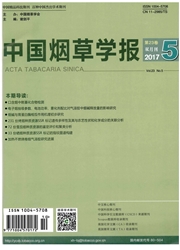

 中文摘要:
中文摘要:
选用氮素利用效率差异较大的两个烤烟基因型中烟100和K326,采用喷施谷氨酰胺合成酶(GS)抑制剂(Glufosinate)和质外体提取等方法分别测定叶片衰老过程中叶片的氮素代谢产物和相关酶活性的变化,并计算气孔氨气补偿点,研究了烤烟叶片衰老期间氮素的转移和再利用特性与氮素利用效率的关系。结果表明,氮低效基因型烤烟中烟100衰老时间早、速度快,GS和NR活性低,GDH活性高,氨气挥发量大,对叶片NH4+的积累反应速度快,再转移量大,与氮高效基因型烤烟K326相比差异显著。说明烤烟叶片衰老期氮素的再转移和再利用,与叶片衰老程度和速度密切相关。
 英文摘要:
英文摘要:
Glutamine synthetase inhibitor (glufosinate) and apoplast extract technique were used to compare differences in N metabolites, activities of related enzymes, and ammonia stomatal compensation point between two flue-cured tobac co genotypes Zhongyang 100 and K326, which have differential N intake efficiency, in order to investigate relationship between N remobilization and recycling and N intake efficiency in tobacco species. Results showed that compared with high N intake efficiency genotype K326, low N intake efficiency genotype Zhongyang 100 aged earlier and more quickly, and exhibited lower activities of glutamine synthetase and nitrate reductase, higher activity of glutamate dehydrogenase, higher NH3 emission, faster response to leaf tissue NH4 ~ accumulation, and greater amount of remobilized N. These re suhs indicated that N remobilization and recycling in tobacco plants and rate of senescence. during leaf senescence was closely related to extent
 同期刊论文项目
同期刊论文项目
 同项目期刊论文
同项目期刊论文
 期刊信息
期刊信息
